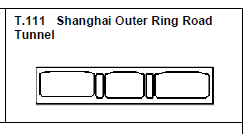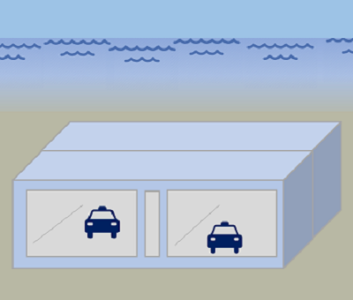Shanghai Outer Ring Road Tunnel
HEIGHT: 9.55m
WIDTH: 43.0m
TOTAL IMMERSED LENGTH: 736.m
DEPTH AT BOTTOM OF STRUCTURE: 33m.
ENVIRONMENTAL CONDITIONS:
This project locates at the coast of East Sea of China where is in the vicinity of the
Changjiang River sea mouth area. Near the mouth of Huangpu river. The ground
condition was very soft muddy clay, clay & sandy silt.
Difficulties of engineering: great impact of tide, large volume of sediment and busy
shipping.
1m/s tidal current.
FABRICATION METHOD:
Elements were fabricated in two dry docks, one on
either side of the east approach section (Pudong
side). Dry docks were for 2 elements and for 5
elements.
WIDTH: 43.0m
TOTAL IMMERSED LENGTH: 736.m
DEPTH AT BOTTOM OF STRUCTURE: 33m.
ENVIRONMENTAL CONDITIONS:
This project locates at the coast of East Sea of China where is in the vicinity of the
Changjiang River sea mouth area. Near the mouth of Huangpu river. The ground
condition was very soft muddy clay, clay & sandy silt.
Difficulties of engineering: great impact of tide, large volume of sediment and busy
shipping.
1m/s tidal current.
FABRICATION METHOD:
Elements were fabricated in two dry docks, one on
either side of the east approach section (Pudong
side). Dry docks were for 2 elements and for 5
elements.
Shanghai,
China

Shanghai Outer-ring Tunnel Construction & Development CO., LTD.
Shanghai Urban Construction Group; Shanghai Tunnel Engineering
Shanghai Tunnel Engineering & Rail Transit Design and Research Institute
Max. length 108m, Min. length 100m.
736m
33m
Project construction
2003-04-30
7
3-tube, 8 lanes in each directions Two services/escape galleries between side tube and mid tube.
9.55m
43m
3-tube, 8 lanes in each directions
Two services/escape galleries between side tube and mid tube.
Two services/escape galleries between side tube and mid tube.
Elements were fabricated in two dry docks, one on
either side of the east approach section (Pudong
side). Dry docks were for 2 elements and for 5
elements.
either side of the east approach section (Pudong
side). Dry docks were for 2 elements and for 5
elements.
Controlling tower for surveying
and positioning, access shaft,
pontoon, jack, etc.
and positioning, access shaft,
pontoon, jack, etc.
This project locates at the coast of East Sea of China where is in the vicinity of the
Changjiang River sea mouth area. Near the mouth of Huangpu river. The ground
condition was very soft muddy clay, clay & sandy silt.
Difficulties of engineering: great impact of tide, large volume of sediment and busy
shipping.
1m/s tidal current.
Changjiang River sea mouth area. Near the mouth of Huangpu river. The ground
condition was very soft muddy clay, clay & sandy silt.
Difficulties of engineering: great impact of tide, large volume of sediment and busy
shipping.
1m/s tidal current.
Two Pontoons were mounted transversely on top of the element for lowering the
element onto its final place. Element was temporarily supported on two nose brackets at
connecting end and on two vertical jacks at the free end. Survey & control tower were
used.
element onto its final place. Element was temporarily supported on two nose brackets at
connecting end and on two vertical jacks at the free end. Survey & control tower were
used.
First seal: GINA rubber gasket
Second seal: OMEGA r seal
Flexible joint is employed.
Post-tensioning cables were
tightened across each joint.
Second seal: OMEGA r seal
Flexible joint is employed.
Post-tensioning cables were
tightened across each joint.
No waterproofing membrane was used. Waterproofing concrete was designed to
prevent cracking, cooling of concrete adopted to control early age stresses and ensure
water-tightness. Spray waterproof membrane was applied only at the concrete joint
section.
prevent cracking, cooling of concrete adopted to control early age stresses and ensure
water-tightness. Spray waterproof membrane was applied only at the concrete joint
section.
Sand-flow method was used. Sand-water mixture was pumped through pipes embedded
in the mid walls and base slab. Cement clinker was mixed with sand to prevent
liquefaction during earthquake.
in the mid walls and base slab. Cement clinker was mixed with sand to prevent
liquefaction during earthquake.
Tuck net riprap method
1.5m backfill cover
1.5m backfill cover
35MPa, anti-permeability grade ³S10,
permeability coefficient of waterproofing
concrete K£10ı12m/s.
permeability coefficient of waterproofing
concrete K£10ı12m/s.
Temporary condition: F=1.02 Permanent condition: F=1.20

